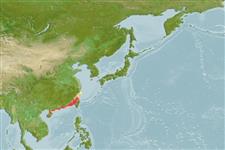Élasmobranches (requins et raies) (sharks and rays) >
Carcharhiniformes (Ground sharks) >
Hemigaleidae (Weasel sharks)
Etymology: Paragaleus: para (Gr.), near, referring to how its dentition is intermediate between Hemigaleus and the triakid Eugaleus (=Galeorhinus). (See ETYFish); tengi: In honor of Teng Huo-Tu (1911-1978), Director, Taiwan Fisheries Research Institute, and authority on Taiwanese elasmobranch fishes. (See ETYFish).
Environment: milieu / climate zone / depth range / distribution range
Écologie
marin démersal. Tropical; 34°N - 15°N
Western Pacific: Japan to Viet Nam, including Hong Kong and Taiwan. Report of a record from off Madagascar may be an undescribed Paragaleus which has just recently been collected.
Taille / Poids / Âge
Maturity: Lm ? range ? - ? cm
Max length : 88.0 cm TL mâle / non sexé; (Ref. 244)
Épines dorsales (Total): 0; Rayons mous dorsaux (Total): 0; Épines anales 0; Rayons mous anaux: 0. Grey or grey-brown above, light below; no prominent markings on body and fins (Ref. 13567).
A little-known inshore shark (Ref. 13567). Viviparous (Ref. 50449). Taken in fisheries where it occurs (Ref. 13567).
Life cycle and mating behavior
Maturité | Reproduction | Frai | Œufs | Fécondité | Larves
Viviparous, placental (Ref. 50449). Distinct pairing with embrace (Ref. 205).
Compagno, L.J.V., 1984. FAO Species Catalogue. Vol. 4. Sharks of the world. An annotated and illustrated catalogue of shark species known to date. Part 2 - Carcharhiniformes. FAO Fish. Synop. 125(4/2):251-655. Rome: FAO. (Ref. 244)
Statut dans la liste rouge de l'IUCN (Ref. 130435)
Utilisations par l'homme
Pêcheries: intérêt commercial mineur
Plus d'informations
PaysZones FAOÉcosystèmesOccurrencesIntroductionsStocksÉcologieRégime alimentaireÉléments du régime alimentaireConsommation alimentaireRation
RéférencesAquacultureProfil d'aquacultureSouchesGénétiqueElectrophoresesHéritabilitéPathologiesTraitementNutrientsMass conversion
CollaborateursImagesStamps, Coins Misc.SonsCiguateraVitesseType de nageSurface branchialeOtolithesCerveauxVision
Outils
Articles particuliers
Télécharger en XML
Sources Internet
Estimates based on models
Preferred temperature (Ref.
123201): 21.5 - 26.9, mean 24.7 °C (based on 164 cells).
Phylogenetic diversity index (Ref.
82804): PD
50 = 0.5664 [Uniqueness, from 0.5 = low to 2.0 = high].
Bayesian length-weight: a=0.00363 (0.00147 - 0.00899), b=3.07 (2.86 - 3.28), in cm total length, based on LWR estimates for this (Sub)family-body shape (Ref.
93245).
Niveau trophique (Ref.
69278): 4.2 ±0.6 se; based on size and trophs of closest relatives
Résilience (Ref.
120179): Très faible, temps minimum de doublement de population supérieur à 14 ans (Fec is assumed to be <10).
Fishing Vulnerability (Ref.
59153): High vulnerability (55 of 100).
Nutrients (Ref.
124155): Calcium = 33.9 [5.5, 192.1] mg/100g; Iron = 0.731 [0.184, 2.180] mg/100g; Protein = 19 [17, 21] %; Omega3 = 0.106 [0.043, 0.251] g/100g; Selenium = 37.8 [11.6, 121.9] μg/100g; VitaminA = 28.3 [8.8, 91.8] μg/100g; Zinc = 0.848 [0.399, 1.545] mg/100g (wet weight);
